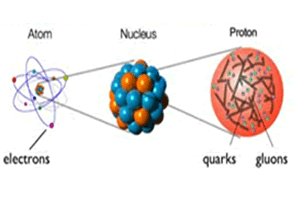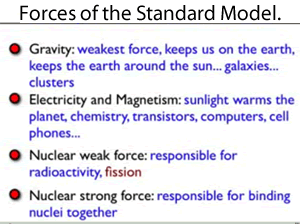Science as a Human Endeavour
Science builds upon current understanding piece by piece. The understanding of the structure of the atom is a classic example of this. The history of the atom goes back to the ancient Greeks. Through the process of observation, formulating hypotheses, predicting and testing we have advanced our knowledge of the atom. Technological advances have also provided the necessary tools to take our investigations further. The Large Hadron Collider is one of the most technologically advanced tools ever built. With this instrument we can study the fundamental particles that formulate matter in our universe. The universe is believed to consist of matter or atoms (4%), dark matter 22% and dark energy (74%). Dark energy uniformly fills all of space with a density of 10−29 grams per cubic centimeter, and is the source of a repulsive force causing the universe to expand.
Energy (E) is regarded to be inter-convertible with matter (mass, m) by Einstein's famous equation E = mc2, where c is the speed of light.

The theories and discoveries of thousands of physicists over the past century have resulted in a remarkable insight into the fundamental structure of matter: everything in the Universe is found to be made from twelve basic building blocks called fundamental particles, governed by four fundamental forces. Our best understanding of how these twelve particles and three of the forces, excluding gravity, are related to each other is encapsulated in the Standard Model. These particles have all been seen either in nature or in the laboratory. The Standard Model also predicts that there is a boson that imparts mass to the elementary particles. The Higgs boson is what imparts mass to the elementary particles and up to now has been elusive.

Since the 1970s, when this model was first put forward by scientists, it has successfully explained a host of experimental results and predicted a number of phenomena and therefore has become established as a well tested physics theory. Only one stumbling block remained, the discovery of the elusive Higgs boson. On Wednesday the 4th July 2012 scientists at the LHC announced the discovery of this fundamental particle.
1) What was the source of the new particles discovered in the 20th Century?
2) How were these particles finally organised?
3) What gave scientists confidence in the Standard Model?
4) The Standard Model incorporates the fundamental building blocks of matter and the fundamental
5) What force holds the nucleus together? What is its force carrier?
6) What made scientists confident that a Higgs particle existed?
Sourced from https://www.youtube.com/watch?v=V0KjXsGRvoA
7) Define a force field.
8) How does the Higgs field differ from other fields such as an electric field or gravitational field?
9) What particles does the Higgs boson not interact with?
10) How does the Higgs particle interact with other particles?
sourced from https://www.youtube.com/watch?v=1_HrQVhgbeo